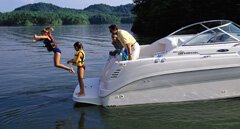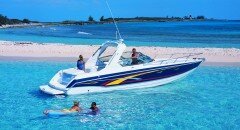 Welcome Aboard! A personal watercraft (PWC) is a boat, and you’re the captain. You are legally in command of a powerboat, and you’re bound by the boating rules of the road as well as the laws and traditions of responsible boating.
Welcome Aboard! A personal watercraft (PWC) is a boat, and you’re the captain. You are legally in command of a powerboat, and you’re bound by the boating rules of the road as well as the laws and traditions of responsible boating.
Registration
Federal regulations require all PWC to be registered and have an identification number. When your registration application is approved, you’ll receive your certificate number, title and validation sticker (if applicable in your state). Follow state and federal guidelines for displaying validation and registration numbers.
To Avoid Collisions
- Scan constantly for people, objects and other watercraft. Be alert for conditions that limit your visibility or block your vision of others.
- Operate defensively at safe speeds and keep a safe distance away from people, objects and other watercraft.
- Do not follow directly behind PWC or other boats.
- Do not go near others to spray or splash them with water.
- Avoid sharp turns or other maneuvers that make it hard for others to avoid you or understand where you are going.
- Avoid areas with submerged objects or shallow water.
- Take early action to avoid collisions. Remember, boats, including PWC, do not have brakes.
- Do not release throttle when trying to steer away from objects—you need throttle to steer. Always check throttle and steering controls for proper operation before starting PWC.
PWC Operating Rules
- Wear a personal floatation device (PFD). All riders must wear a Coast Guard-approved PFD that is suitable for PWC use.
- Wear protective clothing. Severe internal injuries can occur if water is forced into body cavities as a result of falling into the water or being near the jet thrust nozzle. All riders must wear a wet suit bottom or clothing that provides equivalent protection (see Owner’s Manual). Footwear, gloves, and goggles/glasses are recommended.
- Know boating laws. PWC manufacturers recommend a minimum operator age of 16 years. Know the operating age and education requirements for your state. A boating safety course is recommended and may be required in your state.
- Attach engine shut-off cord (lanyard) to wrist and keep it free from the handlebars so that the engine stops if the operator falls off. After riding, remove cord from PWC to avoid unauthorized use by children or others.
- Ride within your limits and avoid aggressive maneuvers to reduce the risk of loss of control, ejection, and collision. A PWC is a high performance boat—not a toy. Sharp turns or jumping wakes or waves can increase the risk of back/spinal injury (paralysis), facial injuries, and broken legs, ankles and other bones. Do not jump wakes or waves. • Do not apply throttle when anyone is at rear of PWC—turn the engine off. Water and/or debris exiting jet thrust nozzle can cause severe injury. • Keep away from intake grate while engine is on. Items such as long hair, loose clothing or PFD straps can become entangled in moving parts resulting in severe injury or drowning. • Never ride after consuming drugs or alcohol.
Think Safe – Ride Safe
- Right of way. Follow basic boating rules. Sailboats (under sail), large commercial vessels, and fishing vessels always have the right of way. Stay to the right when approaching an oncoming craft, so that it passes on your left side. When overtaking another boat, pass on the right or left, but stay clear. If you’re about to cross paths with another boat, the craft on the right has the right of way. Slow down to let the boat continue its course, then pass behind it. Even when you are sure you have the right of way, a good safety rule is to never insist on it. Always ride defensively.
- Wake crossing. If your course takes you across the wake of another boat, make sure your visibility is not obstructed by that boat. Stay far enough behind it so that you can see if other traffic is coming your way.
- Operating speed. Follow local regulations regarding speed limits, whether posted or not. In congested areas, lower your speed.
- Passengers and guests. Never carry more than the maximum passenger load specified for your craft. If you loan your craft to a friend, make sure he or she is of legal age, knows how to operate your craft, and is fully aware of these responsible boating rules. You are responsible when you loan out your PWC.
- Riding position. Passengers should hold on to the person in front of them or the handhold while keeping both feet on the deck for balance during operation or they can lose balance and be injured. Never allow a passenger to ride in front of the operator.
- Maintenance. Check your craft internally and externally before you get on the water. Make sure the throttle and all switches are working properly, fuel and battery lines are properly connected, no fuel is leaking, and cables and steering are functioning.
- Launch ramp etiquette. Be considerate and efficient when launching your PWC. Prepare your craft beforehand, and perform all checks before you get to the water. Wait your turn in line and launch quickly and quietly.
- Sound. Be considerate of waterfront property owners and others near and on the water. Excessive sound from a poorly maintained or modified exhaust system disturbs others and is illegal in many areas.
- Environment. Respect ecologically sensitive areas. Don’t spill fuel or oil and don’t leave litter or other pollutants where they don’t belong. Be sensitive to marine life; the water is their home.
- Other water enthusiasts. PWC riders must share the waterways with other boaters, fisherman, swimmers, surfers and skiers, so respect their rights to access and use the water.
Remember to ride responsibly! It’s up to you to use good judgment and to obey all local ordinances that apply to you and your watercraft.
- Know your craft and how it operates.
- Read all instructional materials and labels from the manufacturer.
- Know your local boating laws.
- Know navigational marks and signs.
- Know the rules of the road.
If you have any further questions regarding personal watercraftb and its use, contact your local marine patrol or boating club, or these organizations for more information:
- Personal Watercraft Industry Association (www.pwia.org)
- U.S. Coast Guard Auxiliary (www.cgaux.org)
- American Watercraft Association (www.awahq.org)
- American Red Cross (www.redcross.org)
- State Boating Authorities (www.nasbla.org)
- U.S. Power Squadrons (www.usps.org)
- National Safe Boating Council (www.safeboatingcouncil.org)

